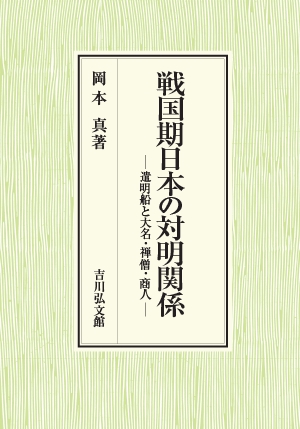
Title
Sengokuki Nihon no Taimin Kankei (Japan's Relations with Ming China in the Sengoku period - Ships Used for Diplomatic Missions to the Ming and Daimyō, Zen Monks, and Merchants)
Size
308pages, A5 format
Language
Japanese
Released
February 22, 2022
ISBN
9784642029742
Published by
Yoshikawa Kobunkan
Book Info
See Book Availability at Library
Japanese Page
In various periods down to the present day relations have been established between Japan and China in response to changing circumstances. During the Ming period, China basically accepted only envoys from the rulers of countries that brought tribute to the Ming emperor, and therefore the Muromachi shogunate, which was desirous of trading with China, assumed the title of “king of Japan” and sent ships to China in the guise of tributary missions. The so-called tally trade was carried out in this manner.
The history of the sending of such ships to Ming China during the Muromachi and Sengoku periods can be summarized as follows. The sending of these ships was initiated at the start of the fifteenth century by Ashikaga Yoshimitsu, the third Muromachi shogun, but was suspended at the time of Ashikaga Yoshimochi (4th shogun) and resumed at the time of Ashikaga Yoshinori (6th shogun). The management of these ships was entrusted to provincial military governors (shugo daimyō), temples, shrines, and other powerful bodies, and from the middle of the fifteenth century disputes about management rights intensified. Especially prominent were the Hosokawa family (Hosokawa Keichō branch), who wielded power in the Kinai and Shikoku regions, and the Ōuchi family in the Chūgoku and Kyūshū regions, and the conflict between them led to the Ningbo incident in 1523. Thereafter the Ōuchi sent ships twice, and these were accepted by the Ming authorities. But because of changes in the situation both in Japan and abroad no further ships were sent to Ming China in the name of the king of Japan.
In the course of conducting research on these ships sent to the Ming, I realized that there were two issues concerning the Sengoku period in particular. One was verifying the validity of the common understanding that views the period up until the Ningbo incident as a period of conflict between the Hosokawa and Ōuchi families and the subsequent period as the period of an Ōuchi monopoly, and the other was examining continuities and discontinuities between the diplomacy and trade conducted by these ships sent to the Ming and, for example, the sending of envoys by the Ōtomo family of Bungo in the mid-sixteenth century, Japan’s trade with Spain and Portugal, and the vermillion-seal ship trade.
This book presents the process whereby I examined these two issues and the conclusions that I reached. In particular, in chapters 2 and 3 of Part 1, I clarify the facts regarding certain ships whose existence had been known through historical sources but whose position in the history of ships sent to the Ming had been unclear, and in doing so I show that conflict had continued during the period known as the period of an Ōuchi monopoly. In addition, in Part 2 I analyze envoys sent by the Ōtomo family, Zen monks of the Daitokuji and Myōshinji branches of the Rinzai sect, and merchants from Sakai and Osaka, and by this means I examine on the basis of actual evidence the continuities and discontinuities between ships sent to the Ming and subsequent diplomacy and trade, which have tended to be treated separately in accounts that separate them into the medieval and early modern periods.
This book is based on academic articles, and so non-specialists may find parts of it difficult to understand. Nonetheless, I hope that it will provide readers with some leads for understanding one aspect of the continuing history of relations between Japan and China.
(Written by: OKAMOTO Makoto / August 26, 2022)
Related Info
The 2nd UTokyo Jiritsu Award for Early Career Academics (The University of Tokyo 2021)
https://www.u-tokyo.ac.jp/ja/research/systems-data/n03_kankojosei.html




 eBook
eBook